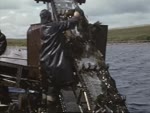CATGUT FILM, the

This video is not available to view remotely
Full length video - onsite only
Please read Understanding catalogue records for help interpreting this information and Using footage for more information about accessing this film.
Title: CATGUT FILM, the
Reference number: 6823
Date: 1953c
Director: [d. Adam H. Malcolm]
Sound: sound
Colour: bw
Fiction: non-fiction
Running time: 15.00 mins
Description:
The history, preparation and use of surgical catgut explained in detail. Includes processes such as washing, storing, filing, unwinding, stretching, sterilising and packing. The use of catgut in surgery is also covered.
Adam Malcolm was an active member of the Scottish Educational Film Association, directing and editing many of their films. Adam Malcolm himself talks about this film on the Grampian TV series 'THE WAY IT WAS'.
This film won the Glasgow Scientific Film Society Prize - £2-2/- at the Scottish Amateur Film Festival, 1953.
Shotlist:
Please note viewing copy is the 'BB version' , being a slightly shorter version with additional introduction.
(0.00) Scottish Association of Amateur Cinematographers 1953 Festival. Highly Commended Film. This film has been awarded a Silver Trophy as one of the Amateur Cine World Ten Best Films of 1953 (0.19) Ethicon Presents title (0.49) surgical catgut in a small glass tube, a man how to clean the tube to remove all traces of dirt (1.21) shot of three people lined up at sink scrubbing catgut tubes with soap and water, they then set them aside on metal tray to drain (2.21) tubes are stored in jars containing antiseptic solution (2.47) man demonstrates how the tubes and contents are lighter than water and how an aqueous solution won't work for storage (3.03) tubes stored in antiseptic solution, and then shot of jars prestored by manufacturer (3.40) tubes are transferred aseptically to sterile tray by surgeons assistant (3.58) man looks puzzled as he toys with a tube of catgut - how do you get it out of the tube? intercut with shot of ship in a bottle (4.34) file the score on the tube and the tube breaks without splintering - demonstration of same (4.59) man reading book 'Physical Properties of Glass', as he continues to puzzle over how to get catgut out (5.15) repeated shot as score is made with file and the catgut removed (5.30) spool of catgut and label taken out, unwinding catgut, doubled up to remove kinks and leave what is called the 'basic elasticity' (6.42) catgut, after being cut to surgeons requirements, the catgut is put in the folds of a dry, sterile towel (6.55) man still pondering books such as 'The Strength of Plastics and Glass' (7.07) sometimes cat gut is stored this way, wound around a towel like a napkin ring (7.16) operation where catgut is used to close wound (7.40) bundle of lamb's intestines on a rack, fresh from the slaughterhouse (7.54) cut lengthways with sharp knife into two ribbons (8.20) ribbons are then scraped and squeezed and led between rollers , completely cleaned of slime and mucus (8.37) laboratory shot, as tests are made on the structure of the gut and on the cleaning solution (8.45) cutting to length and then the sizing of the ribbons is carried out and loops are tied at both ends (9.40) the ribbons are then twisted by machine (9.59) twisted ribbons are now put under tension and left to dry, c/u temperature and humidity controls (10.19) polishing process (10.43) thickness of catgut are measured and a complete scientific survey is carried out on each sample, across all physical and chemical properties such as strength and purity (11.43) finishing department, some are finished with a needle at one end, wound onto slacks and put into tubes with appropriate labelling (12.12) tubes loaded into heat steriliser and samples tested for sterility (13.09) man holds up test tubes and sterility tests are read (13.19) packing tubes into boxes (13.41) gvs operation using catgut to seal opening (14.09) sum up of the various processes involved (14.48) The End (15.00)






